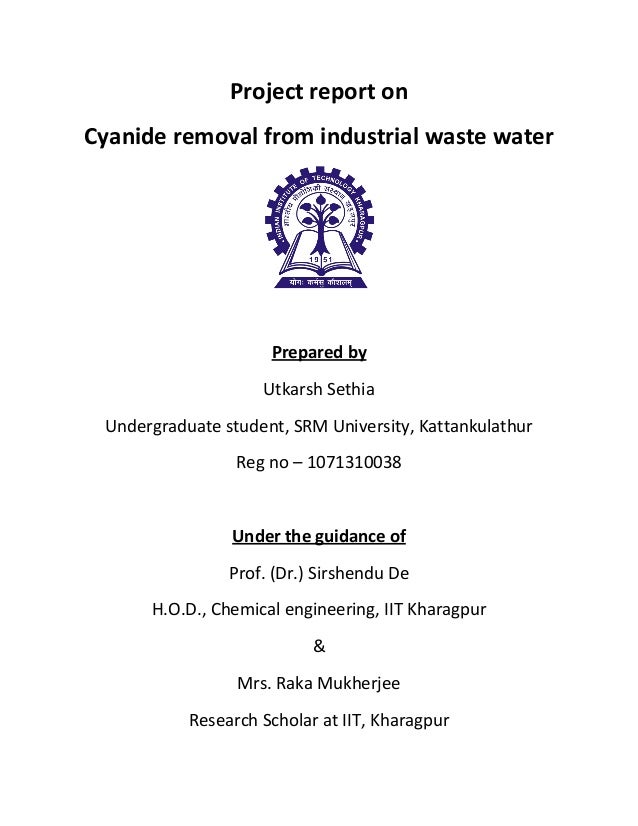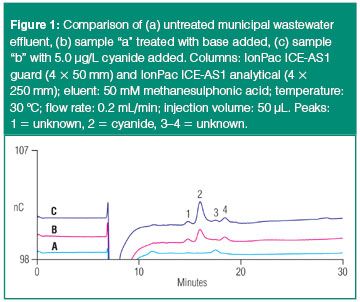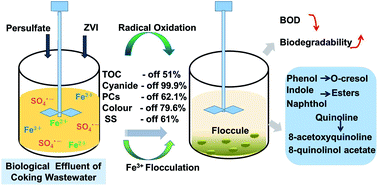The role of the wastewater treatment plant operator has become very important in the prevention of environmental degradation in Michigan. The cyanide in the sample is distilled and trapped in a sodium hydroxide solution.

Pdf Cyanide Generation During Preservation Of Chlorinated Wastewater Effluent Samples For Total Cyanide Analysis Semantic Scholar
Jchps Com

Effect Of Nacl In Cyanide Destruction Download Table
Wastewater samples are shown to aid in the discussion and to showcase the treated wastewater effluent quality by comparing it to a sample of the Citys drinking water.

Cyanide in wastewater effluent. Chapter 312 - Sludge Use Disposal and Transportation. EPA publishes laboratory analytical methods test procedures that are used by industries and municipalities to analyze the chemical physical and biological components of wastewater and other environmental samples required by the Clean Water Act. 21 Inorganic industrial wastewater Inorganic industrial wastewater is produced mainly in the coal and steel industry in the.
Chapter 315 - Pretreatment Regulations for Existing and New Sources of Pollution. As an example a city with a population of 500000 and water consumption of 200 ld per person would produce approximately 85000 m 3 d 30 Mm³year of wastewater assuming 85 inflow to the public sewerage system. Wastewater Class B Certification Practice Quiz.
Total cyanide is an analytically defined term that refers to the sum total of. When thick scummy foam is seen on the aeration tank surface. Inorganic industrial wastewater and organic industrial wastewater.
Determination of hydrogen cyanide by headspace gas chromatography using an improved method of standardization. A common remedy for activated sludge system problems is to increase the waste activated sludge WAS flow rate. Wastewater must be designed specifically for the particular type of effluent produced.
Matrix Freshwater Seawater Groundwater Wastewater. Carr SA Baird RB Lin BT 1997. State and Federal requirements vary but non-compliance may result in fines and other consequences.
Chapter 311 - Watershed Protection. It is capable of removing suspended solid organic compounds and inorganic contaminants such as heavy metals. Same industry and wastewater is mixed during treatment and discharge effluent standards for each.
The objective is to standardize effluent quality monitoring procedures to ensure that the water quality monitoring programs follow certain Quality AssuranceQuality Control QAQC protocols and acceptable field methods. Cyanide and dissolved organic carbon DOC. Cardeal ZL Pradeau D Hamon M 1993.
The objective is to produce an effluent that meets limits or guidelines that have been set. Chapter 314 - Toxic Pollutant Effluent Standards. The trade effluent shall be analysed in accordance with the latest edition of Standard Methods for the Examination of Water and Wastewater published jointly by the American Water Works Association and the Water Pollution Control Federation of the United States.
Soil Sediment Sludge and Solid wastes are applicable to this method after extraction by the BC MOE soil extraction method Ref. Generally industrial wastewater can be divided into two types. When would an increase of WAS rate NOT be correct.
The tour may proceed outside for a walkthrough of the various unit processes that were discussed during the scaled model segment. Wastewater originates from homes businesses industry as well as storm drains and rainwater runoff. EPA promulgated the Organic Chemicals Plastics and Synthetic Fibers OCPSF Effluent Guidelines and Standards 40 CFR Part 414 in 1987 and amended the regulation in 1989 1990 1992 and 1993.
Effluent standards are limits in terms of concentration andor volume that any wastewater discharge coming from a point source ie. Electroplating and metal surface treatment processes generate significant quantities of wastewaters containing heavy metals such as cadmium zinc lead chromium nickel copper vanadium platinum silver and titanium from a variety of applications. Term and definitions Total Cyanide.
Effluent Treatment Plant or ETP is one type of waste water treatment method which is particularly designed to purify industrial waste water for its reuse and its aim is to release safe water to environment from the harmful effect caused by the effluent. Volume II is a guide to monitor the quality of effluent from industries and other regulated wastewater dischargers. These consist of a set of water quality parameters and their corresponding numerical limits.
Wastewater derived interferences in cyanide analysis. EXAMPLE 1 - AGRONOMIC AND ECONOMIC BENEFITS OF WASTEWATER USE IN IRRIGATION. This material may include excrement detergents from washing clothes and dishes food scraps grease oils plastics salts sand grit and heavy metals.
Cyanide 10 Oil and grease n-hexane extract 10 Soluble iron 10 Soluble manganese 10 Cadmium 003 Lead 10 Total chromium 20. Generally wastewater contains around 999 water by weight with the remaining 01 representing dissolved solids or other suspended materials. Industrial effluents contain various materials depending on the industry.
If treated wastewater effluent is used in carefully controlled irrigation at an application rate of. Chapter 309 - Domestic Wastewater Effluent Limitation and Plant Siting. The excretion of 14C-labeled cyanide in rats exposed to chronic intake of potassium cyanide was studied in rats exposed to daily intake of labeled potassium cyanide in the diet for 6 weeks.
The water bills will be used to verify the reported flow rate. Industrial wastewater streams containing heavy metals are produced from different industries. Sensor requirements will vary based on the type of effluent being treated.
After treatment the treated industrial wastewater or effluent may be reused or released to a sanitary sewer or to a surface water in the environment. When pin-point floc is observed on the clarifier surface. Companies that have an approved effluent wastewater flow measurement system must provide totalizer readings for the last twelve 12 months and must indicate the totalizer units eg hundreds of gallons.
Wastewater Treated Effluent Discharge Standards in Different Countries Malaysia Sewage and Industrial Effluent Discharge Standards According to Malaysias Environmental Law ENVIRONMENTAL QUALITY ACT 1974 the Malaysia Environmental Quality Sewage and. Industrial operations that discharge effluent into sewer systems lakes or streams are required to neutralize effluent prior to discharge. Some industrial facilities generate wastewater that can be treated in sewage treatment plants.
The peak flow rate in gallons per minute must also be provided on line 16. Urinary excretion was the main route of elimination of cyanide carbon in these rats accounting for 83 of the total excreted radioactivity in 12 hr and 89 of the total excreted radioactivity in 24 hr. Chapter 319 - General Regulations Incorporated.
The regulation covers wastewater discharges from more than 1000 chemical facilities. Detoxification processes are used to reduce the concentrations of toxic constituents in tailings streams and process solutions either by dilution removal or conversion to a less toxic chemical form sometimes referred to asdestruction or degradation in the case of toxic cyanide species. Method D2036-09A the cyanide is treated with strong acid and a catalyst during distillation and measured by titration gas diffusion amperometry spectrophotometry ion-selective electrode ion chromatography or flow injection analysis.
The operator is expected to optimize treatment to obtain the highest quality effluent possible as well as to demonstrate that the effluent is indeed within the set standards. Membrane Filtration Membrane filtration has received considerable attention for the treatment of inorganic effluent. Industrial plants and municipal sewerage systems shall meet.
Industrial wastewater treatment describes the processes used for treating wastewater that is produced by industries as an undesirable by-product.
White Paper Total Cyanide Analysis Of Npdes Wastewater Samples By Astm D 7511 09e2

What To Do If You Have Cyanide In Your Industrial Wastewater

Measurement Of Free Cyanide In Well Water Tap Water And Effluent Of Download Table
Sulfate Radical Oxidation Combined With Iron Flocculation For Upgrading Biological Effluent Of Coking Wastewater Rsc Advances Rsc Publishing

Report On Cyanide Removal From Industrial Waste Water

Adsorptive Removal Of Cyanide From Coke Oven Wastewater Onto Zero Valent Iron Optimization Through Response Surface Methodology Isotherm And Kinetic Studies Sciencedirect

Enhanced Precipitation Of Cyanide From Electroplating Wastewater Via Self Assembly Of Bimetal Cyanide Complex Sciencedirect

Determination Of Total Cyanide In Municipal Wastewater Using Ice Pad

